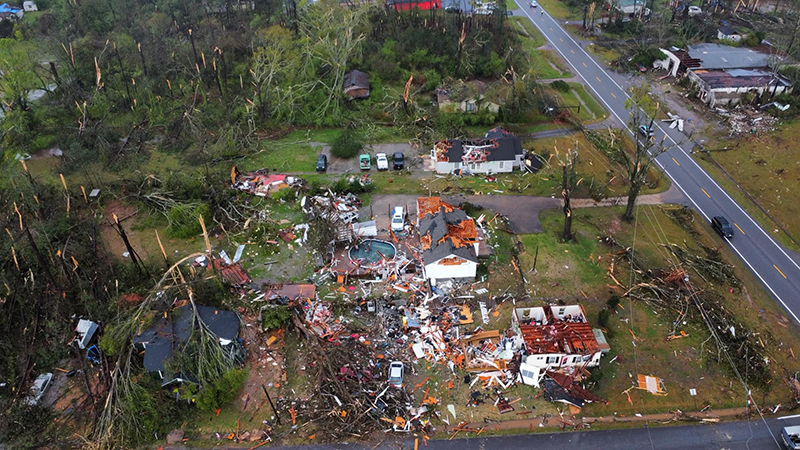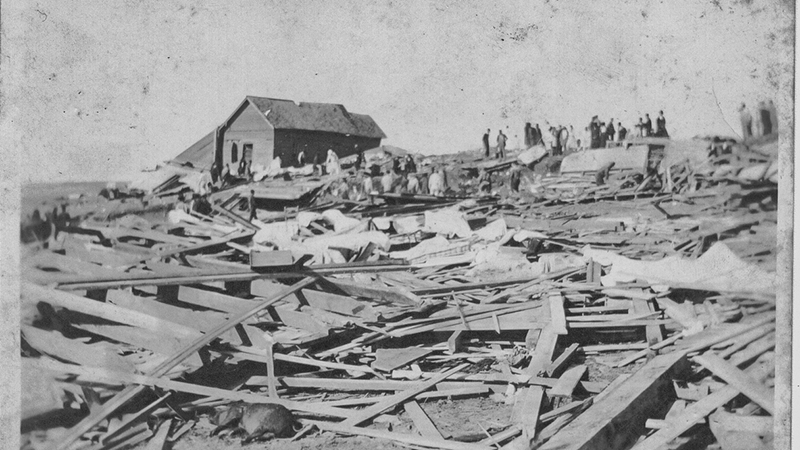Is it just bad luck? Meteorologists take closer look at Troup County’s run of four tornadoes in 73 days
Published 4:42 pm Tuesday, April 4, 2023

- --Photo by Hunter Webb
|
Getting your Trinity Audio player ready...
|
In the span of 73 days, Troup County experienced four tornadoes.
Last week, the fourth— and the strongest tornado of the four — impacted unincorporated Troup County, right outside the city limits of West Point. Many are wondering why Troup County is seeing so many twisters in 2023 and if there’s any scientific reasoning to back up the increase.
The first two tornadoes hit the area on Jan. 12, one going through northern Troup County and one through the southern portion of the county. Both were classified as EF-2 tornadoes, with over 100 homes receiving damage.
On Feb. 17, in the wee hours of the morning, a small EF-1 tornado hit the area, causing damage to homes, Beacon Brewery and sending a pair of bleachers through the fencing at Callaway Stadium.
In the March 26 storm, approximately 100 homes were damaged, with the most significantly impacted area being near West Point Road.
Fortunately, experts say the run on tornadic storms is unlikely to continue, at least at their current rate.
“Bottom line is it’s mostly a matter of luck,” said James Spann, chief meteorologist at ABC 33/40 in Birmingham, Alabama. “We’ve always had violent tornadoes here in the deep south and November through May.”
For most in Alabama, Spann has become the go-to expert when severe weather strikes. His work on a local level has led to him becoming well-known outside of the state.
Spann referenced Oak Grove, Alabama, which had an EF-5 tornado in 1998. In the years that followed, Oak Grove also was hit by other tornadoes, so he got asked a lot about the area’s tendency for twisters. However, Oak Grove has not seen a major tornado in many years.
“About the time you think that you’re going get hit every three months or every four months and you need to move out of here because something’s happened … then you don’t have one for 20 years, and it’ll be like that there,” Spann said. “It’s just mostly a matter of luck.”
Brandon Buckingham, meteorologist with Accuweather, said the above-average water temperatures across the western Atlantic and Gulf of Mexico could be to blame. He said on all three days when Troup County had a tornado this year, a powerful cold front moved across the southeastern United States.
However, like Spann, he said Troup County has just been really unlucky in 2023.
“In terms of the four tornadoes in one county itself, it’s unfortunate enough that I’d partially chalk it up to just having terrible luck,” he said.
IS TORNADO ALLEY SHIFTING TO THE SOUTHEAST?
Spann said there might be some correlation between Troup County’s current run of tornadoes and research from 2018 by meteorology professor Victor Gensini of Northern Illinois University and Harold Brooks of NOAA’s National Severe Storms Laboratory. The researchers noted that the so-called tornado alley of Texas, Oklahoma and northeast Colorado is seeing less tornadoes over the last 40 years.
Meanwhile, states like Mississippi, Alabama, Arkansas, Missouri, Illinois, Indiana, Tennessee and Kentucky are seeing more tornadoes over that same period.
A tornado project from the Savannah Morning News shows that Georgia has seen an uptick in tornadoes over the last two decades, though it’s hard to know how much media reports and the ability to share information on the internet has changed tornado reporting.
From 2013-2022, the project shows 541 tornadoes hit Georgia. From 2003-2012, the number was 469 and from 1993-2002, 245 tornadoes hit the state.
TROUP’S TORNADO HISTORY
The Troup County Archives assisted The LaGrange Daily News with information on previous tornadoes that hit Troup County. Based on that data, arguably the best comparison for 2023 is 1884 when several tornadoes impacted the area in March and April. In May 1884, it was reported by the LaGrange Reporter that several storm shelters were being built in the area.
 For the March 1884 storm, the fear was very clear in reporting after the storm.
For the March 1884 storm, the fear was very clear in reporting after the storm.
“As soon as the ominous roaring was heard in the West, there was a rush. Mothers, with blanched cheeks, wrung their hands but felt powerless to protect their babes; some resorted to prayer: little children ran and cried, as they beheld the red gyrations revolving and sweeping onward; strong men, pallid with fear either stood still in their dread or, animated by a restless impulse, sought the protection of cellars…,” the paper reported.
The story also called the tornado that day a “funnel-shaped aerial monster, now too well known to Georgians as a ‘cyclone.’”
On March 31, 1920, a very significant tornado hit Troup County, arguably the worst in our county’s history. The tornado hit West Point and southeast LaGrange and went on to Mountville. Thirty-six people died and more than 100 were injured.
The headline in the LaGrange Reporter read that “death, desolation and destruction were left in its path.”
A storm events database from the National Centers for Environmental Information lists 18 tornadoes in Troup County between 1956 and 2017, with only two — both in 1964 — EF-3 or stronger like the March 26, 2023, tornado.
ROLE THE LAKE PLAYS
Since West Point Lake was installed in 1965 and first flooded in 1975, there’s been talk in Troup County that the lake might play a role in disarming severe storms that threaten the area.
Spann said that is a myth.
“If anything, the lack of friction over a body of water would increase the intensity of a tornado,” Spann said.
Spann said he’s heard everything from bodies of water to interstates to hills preventing tornadoes, but all of it is a myth. Tornadoes can strike anywhere.
“The last thing you want to do is scare anybody because all that’s out there is scaring people. But at the same time, they’ve got to understand that it can happen to anybody,” Spann said.
Buckingham said looking at West Point Lake, he doesn’t believe it’s large enough to have any impact on thunderstorms. He said larger lakes, such as the Great Lakes, may have that effect.
HOW TO PREPARE
Spann said it’s important for people to realize that tornado season for both Georgia and Alabama is November through May, meaning it’s not just in the Spring.
He said although Troup County has had a severe active severe weather year, it’s been a fairly average season for the Southeast.
“I’d say it’s pretty much on par for being an average season. So far,” Spann said. “Now, we’ve got to get to April. Who knows.”
Spann mentioned that April was looking pretty active for the first few weeks, though his interview with the LDN was conducted at the end of March. Across the United States, several rounds of severe weather have impacted the Midwest since the interview.
He said that he recommends that people purchase weather radios and not rely on cell phones during emergencies. The destruction of a local cell tower during the March 26 tornado left some without cell service for days. It also could’ve delayed emergency notifications.
“Everybody thinks their cell phones are going to go off and cell service often fails during a tornado emergency,” he said. “We’ve got to do a better job of getting weather radios in homes, especially in low-income homes where they can’t afford it.”



